INFINITI EX 2011 Service Manual
Manufacturer: INFINITI, Model Year: 2011, Model line: EX, Model: INFINITI EX 2011Pages: 480, PDF Size: 4.04 MB
Page 41 of 480
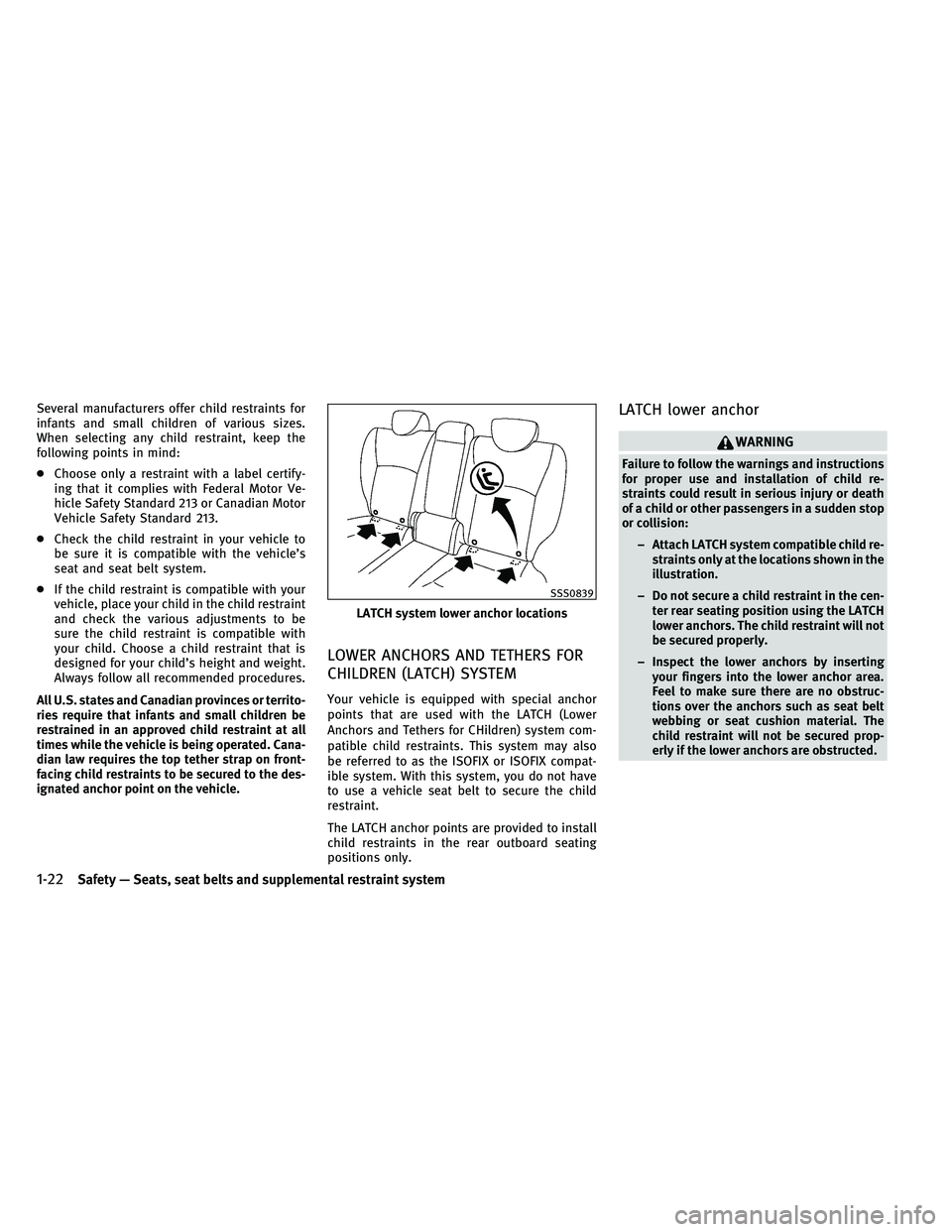
Several manufacturers offer child restraints for
infants and small children of various sizes.
When selecting any child restraint, keep the
following points in mind:
●Choose only a restraint with a label certify-
ing that it complies with Federal Motor Ve-
hicle Safety Standard 213 or Canadian Motor
Vehicle Safety Standard 213.
● Check the child restraint in your vehicle to
be sure it is compatible with the vehicle’s
seat and seat belt system.
● If the child restraint is compatible with your
vehicle, place your child in the child restraint
and check the various adjustments to be
sure the child restraint is compatible with
your child. Choose a child restraint that is
designed for your child’s height and weight.
Always follow all recommended procedures.
All U.S. states and Canadian provinces or territo-
ries require that infants and small children be
restrained in an approved child restraint at all
times while the vehicle is being operated. Cana-
dian law requires the top tether strap on front-
facing child restraints to be secured to the des-
ignated anchor point on the vehicle.
LOWER ANCHORS AND TETHERS FOR
CHILDREN (LATCH) SYSTEM
Your vehicle is equipped with special anchor
points that are used with the LATCH (Lower
Anchors and Tethers for CHildren) system com-
patible child restraints. This system may also
be referred to as the ISOFIX or ISOFIX compat-
ible system. With this system, you do not have
to use a vehicle seat belt to secure the child
restraint.
The LATCH anchor points are provided to install
child restraints in the rear outboard seating
positions only.
LATCH lower anchor
WARNING
Failure to follow the warnings and instructions
for proper use and installation of child re-
straints could result in serious injury or death
of a child or other passengers in a sudden stop
or collision: – Attach LATCH system compatible child re-straints only at the locations shown in the
illustration.
– Do not secure a child restraint in the cen- ter rear seating position using the LATCH
lower anchors. The child restraint will not
be secured properly.
– Inspect the lower anchors by inserting your fingers into the lower anchor area.
Feel to make sure there are no obstruc-
tions over the anchors such as seat belt
webbing or seat cushion material. The
child restraint will not be secured prop-
erly if the lower anchors are obstructed.
LATCH system lower anchor locations
SSS0839
1-22Safety — Seats, seat belts and supplemental restraint system
Page 42 of 480
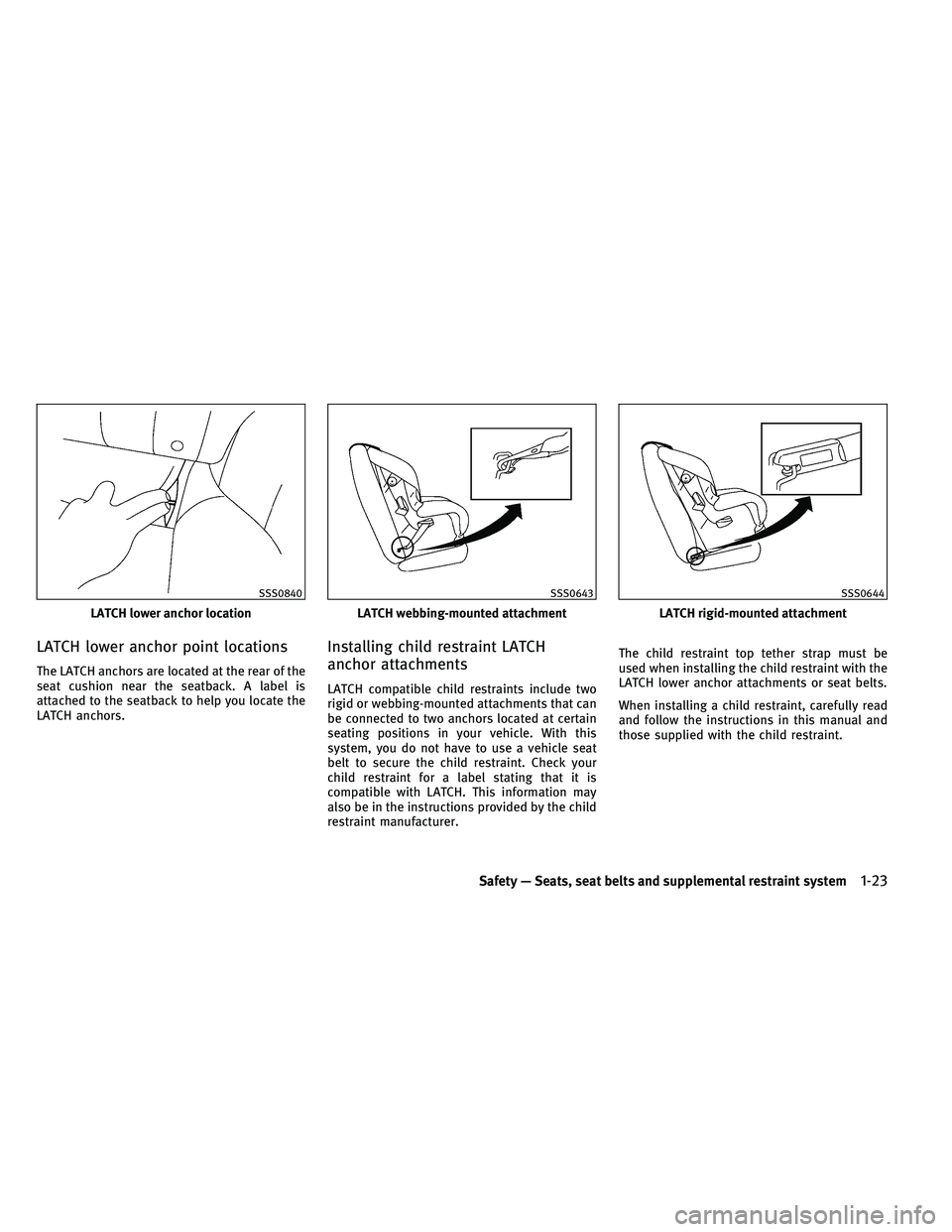
LATCH lower anchor point locations
The LATCH anchors are located at the rear of the
seat cushion near the seatback. A label is
attached to the seatback to help you locate the
LATCH anchors.
Installing child restraint LATCH
anchor attachments
LATCH compatible child restraints include two
rigid or webbing-mounted attachments that can
be connected to two anchors located at certain
seating positions in your vehicle. With this
system, you do not have to use a vehicle seat
belt to secure the child restraint. Check your
child restraint for a label stating that it is
compatible with LATCH. This information may
also be in the instructions provided by the child
restraint manufacturer.The child restraint top tether strap must be
used when installing the child restraint with the
LATCH lower anchor attachments or seat belts.
When installing a child restraint, carefully read
and follow the instructions in this manual and
those supplied with the child restraint.
LATCH lower anchor location
SSS0840
LATCH webbing-mounted attachment
SSS0643
LATCH rigid-mounted attachment
SSS0644
Safety — Seats, seat belts and supplemental restraint system1-23
Page 43 of 480
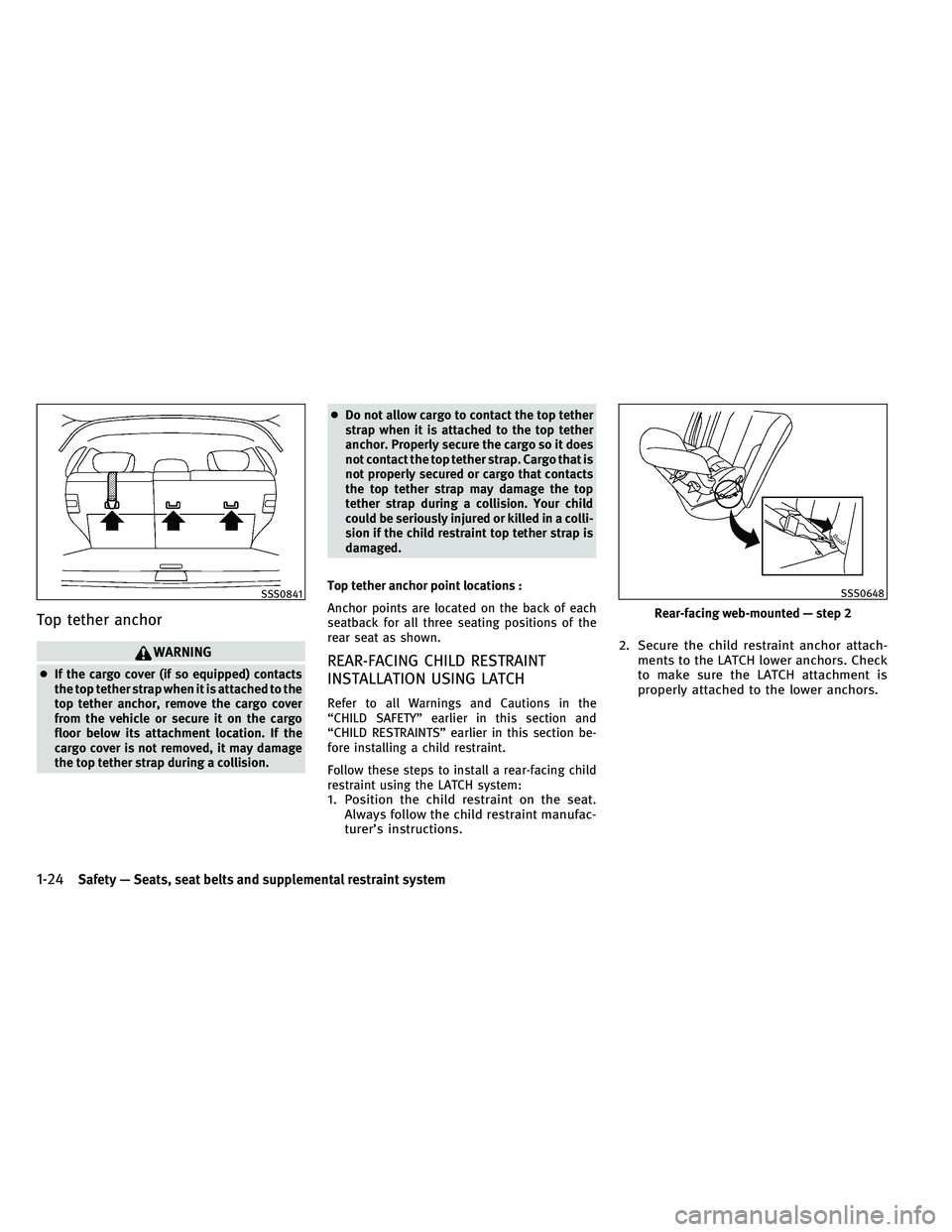
Top tether anchor
WARNING
●If the cargo cover (if so equipped) contacts
the top tether strap when it is attached to the
top tether anchor, remove the cargo cover
from the vehicle or secure it on the cargo
floor below its attachment location. If the
cargo cover is not removed, it may damage
the top tether strap during a collision. ●
Do not allow cargo to contact the top tether
strap when it is attached to the top tether
anchor. Properly secure the cargo so it does
not contact the top tether strap. Cargo that is
not properly secured or cargo that contacts
the top tether strap may damage the top
tether strap during a collision. Your child
could be seriously injured or killed in a colli-
sion if the child restraint top tether strap is
damaged.
Top tether anchor point locations :
Anchor points are located on the back of each
seatback for all three seating positions of the
rear seat as shown.REAR-FACING CHILD RESTRAINT
INSTALLATION USING LATCH
Refer to all Warnings and Cautions in the
“CHILD SAFETY” earlier in this section and
“CHILD RESTRAINTS” earlier in this section be-
fore installing a child restraint.
Follow these steps to install a rear-facing child
restraint using the LATCH system:
1. Position the child restraint on the seat. Always follow the child restraint manufac-
turer’s instructions. 2. Secure the child restraint anchor attach-
ments to the LATCH lower anchors. Check
to make sure the LATCH attachment is
properly attached to the lower anchors.
SSS0841
Rear-facing web-mounted — step 2
SSS0648
1-24Safety — Seats, seat belts and supplemental restraint system
Page 44 of 480
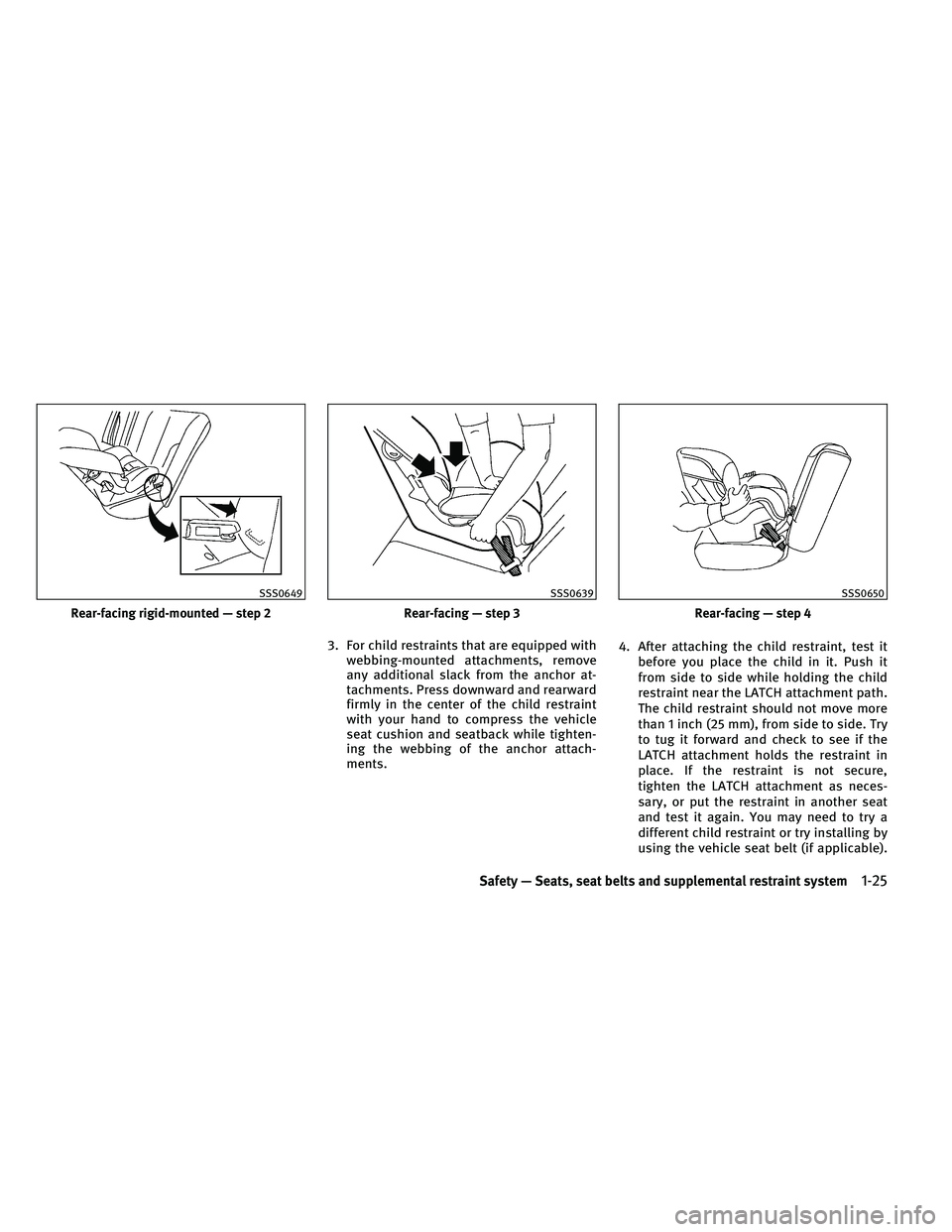
3. For child restraints that are equipped withwebbing-mounted attachments, remove
any additional slack from the anchor at-
tachments. Press downward and rearward
firmly in the center of the child restraint
with your hand to compress the vehicle
seat cushion and seatback while tighten-
ing the webbing of the anchor attach-
ments. 4. After attaching the child restraint, test it
before you place the child in it. Push it
from side to side while holding the child
restraint near the LATCH attachment path.
The child restraint should not move more
than 1 inch (25 mm), from side to side. Try
to tug it forward and check to see if the
LATCH attachment holds the restraint in
place. If the restraint is not secure,
tighten the LATCH attachment as neces-
sary, or put the restraint in another seat
and test it again. You may need to try a
different child restraint or try installing by
using the vehicle seat belt (if applicable).
Rear-facing rigid-mounted — step 2
SSS0649
Rear-facing — step 3
SSS0639
Rear-facing — step 4
SSS0650
Safety — Seats, seat belts and supplemental restraint system1-25
Page 45 of 480
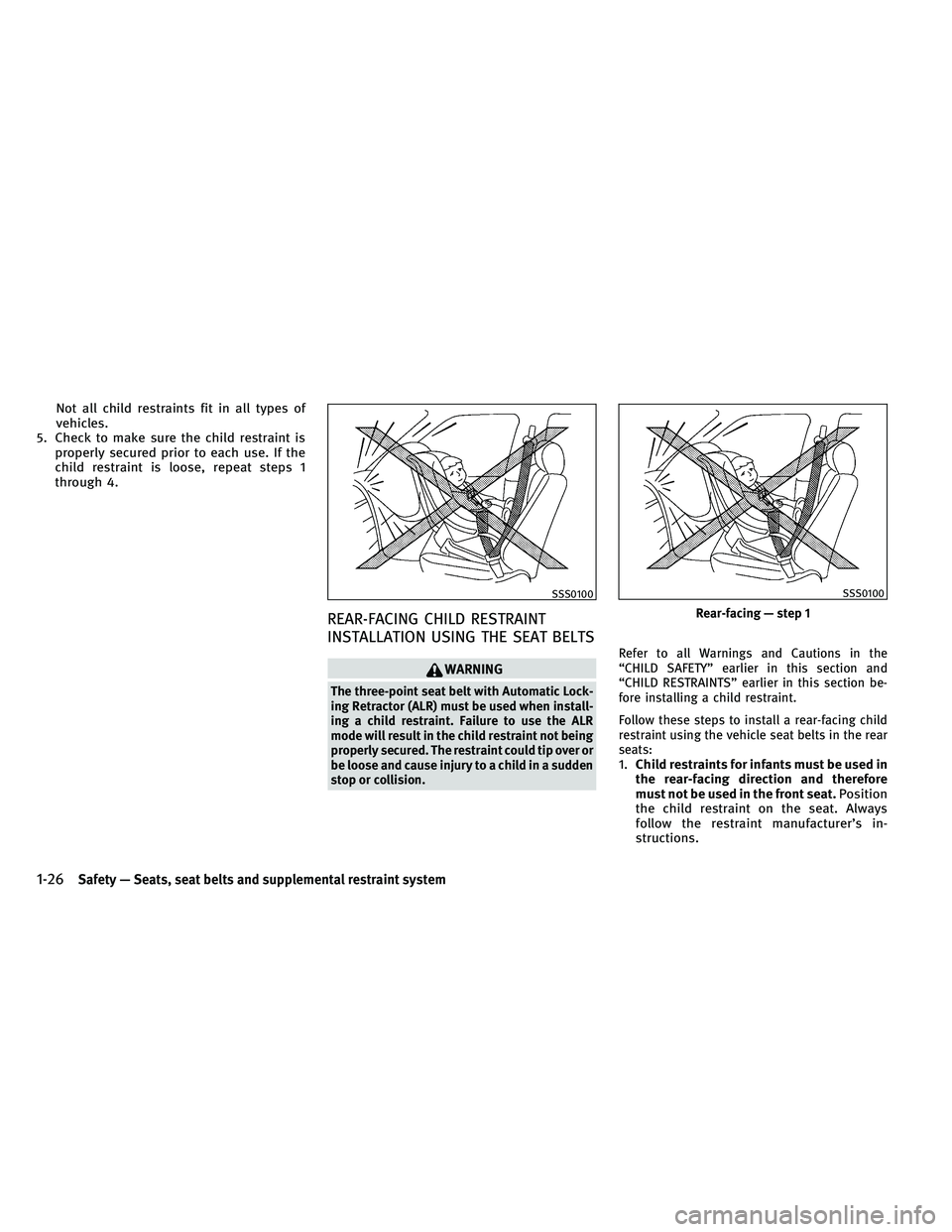
Not all child restraints fit in all types of
vehicles.
5. Check to make sure the child restraint is properly secured prior to each use. If the
child restraint is loose, repeat steps 1
through 4.
REAR-FACING CHILD RESTRAINT
INSTALLATION USING THE SEAT BELTS
WARNING
The three-point seat belt with Automatic Lock-
ing Retractor (ALR) must be used when install-
ing a child restraint. Failure to use the ALR
mode will result in the child restraint not being
properly secured. The restraint could tip over or
be loose and cause injury to a child in a sudden
stop or collision. Refer to all Warnings and Cautions in the
“CHILD SAFETY” earlier in this section and
“CHILD RESTRAINTS” earlier in this section be-
fore installing a child restraint.
Follow these steps to install a rear-facing child
restraint using the vehicle seat belts in the rear
seats:
1.
Child restraints for infants must be used in
the rear-facing direction and therefore
must not be used in the front seat. Position
the child restraint on the seat. Always
follow the restraint manufacturer’s in-
structions.
SSS0100
Rear-facing — step 1
SSS0100
1-26Safety — Seats, seat belts and supplemental restraint system
Page 46 of 480
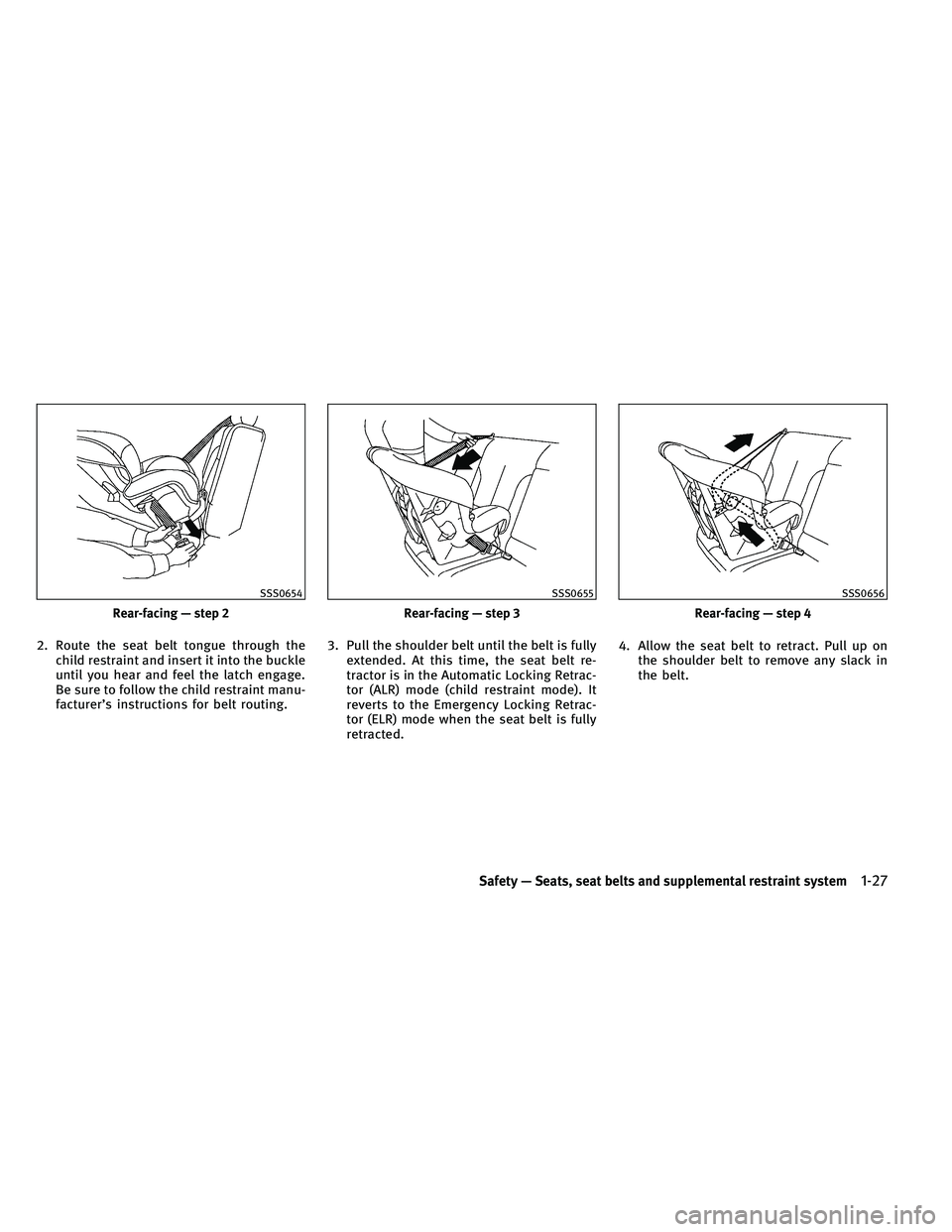
2. Route the seat belt tongue through thechild restraint and insert it into the buckle
until you hear and feel the latch engage.
Be sure to follow the child restraint manu-
facturer’s instructions for belt routing. 3. Pull the shoulder belt until the belt is fully
extended. At this time, the seat belt re-
tractor is in the Automatic Locking Retrac-
tor (ALR) mode (child restraint mode). It
reverts to the Emergency Locking Retrac-
tor (ELR) mode when the seat belt is fully
retracted. 4. Allow the seat belt to retract. Pull up on
the shoulder belt to remove any slack in
the belt.
Rear-facing — step 2
SSS0654
Rear-facing — step 3
SSS0655
Rear-facing — step 4
SSS0656
Safety — Seats, seat belts and supplemental restraint system1-27
Page 47 of 480
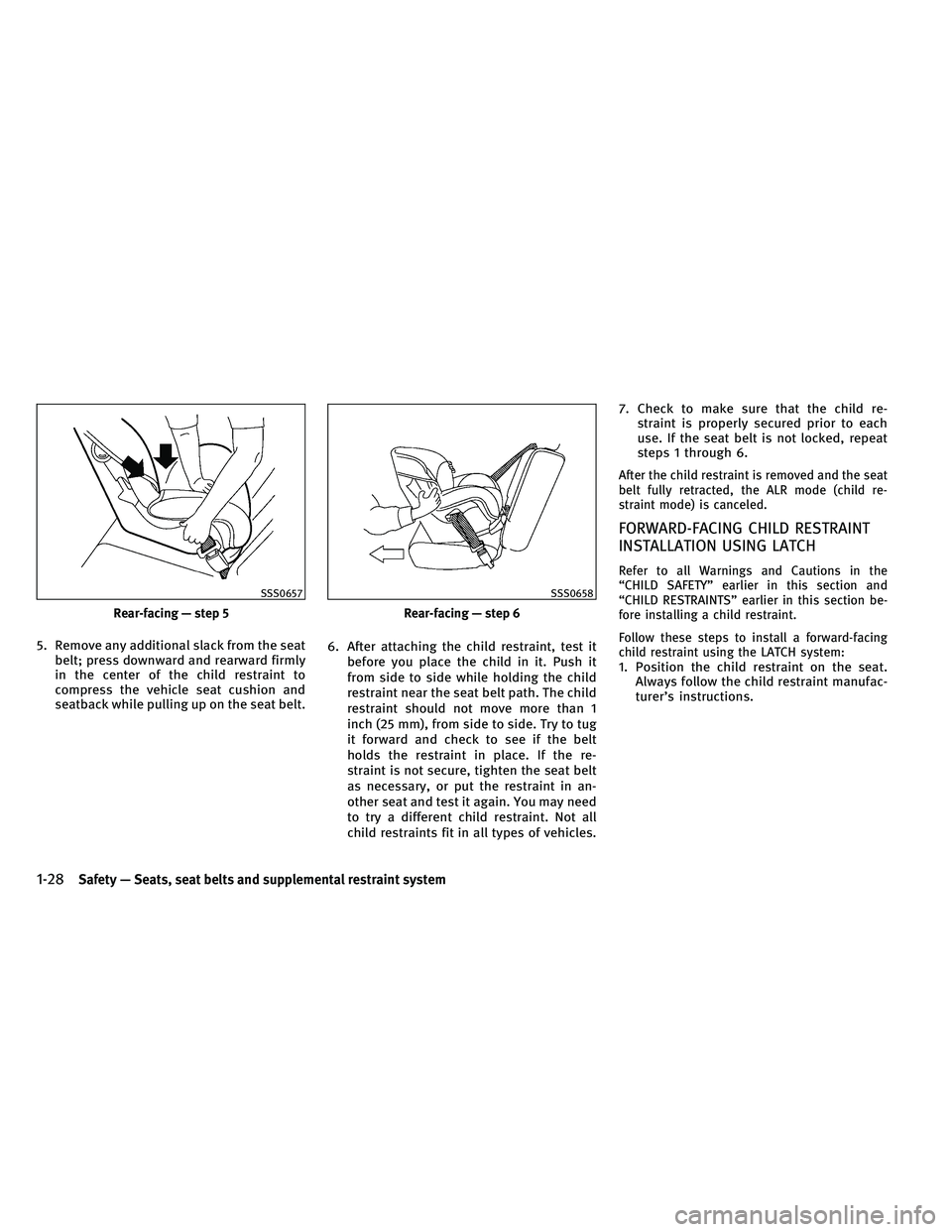
5. Remove any additional slack from the seatbelt; press downward and rearward firmly
in the center of the child restraint to
compress the vehicle seat cushion and
seatback while pulling up on the seat belt. 6. After attaching the child restraint, test it
before you place the child in it. Push it
from side to side while holding the child
restraint near the seat belt path. The child
restraint should not move more than 1
inch (25 mm), from side to side. Try to tug
it forward and check to see if the belt
holds the restraint in place. If the re-
straint is not secure, tighten the seat belt
as necessary, or put the restraint in an-
other seat and test it again. You may need
to try a different child restraint. Not all
child restraints fit in all types of vehicles. 7. Check to make sure that the child re-
straint is properly secured prior to each
use. If the seat belt is not locked, repeat
steps 1 through 6.
After the child restraint is removed and the seat
belt fully retracted, the ALR mode (child re-
straint mode) is canceled.
FORWARD-FACING CHILD RESTRAINT
INSTALLATION USING LATCH
Refer to all Warnings and Cautions in the
“CHILD SAFETY” earlier in this section and
“CHILD RESTRAINTS” earlier in this section be-
fore installing a child restraint.
Follow these steps to install a forward-facing
child restraint using the LATCH system:
1. Position the child restraint on the seat.Always follow the child restraint manufac-
turer’s instructions.
Rear-facing — step 5
SSS0657
Rear-facing — step 6
SSS0658
1-28Safety — Seats, seat belts and supplemental restraint system
Page 48 of 480
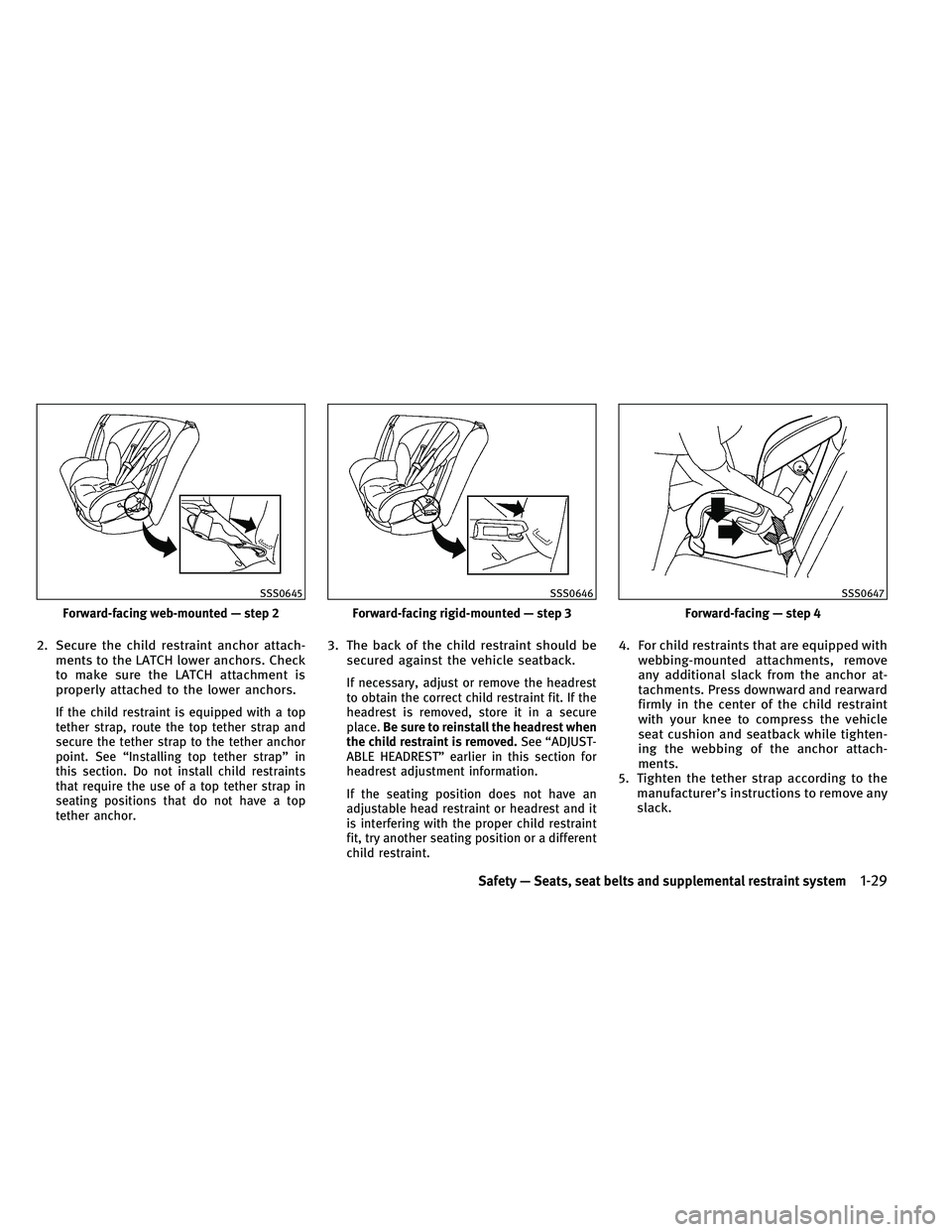
2. Secure the child restraint anchor attach-ments to the LATCH lower anchors. Check
to make sure the LATCH attachment is
properly attached to the lower anchors.
If the child restraint is equipped with a top
tether strap, route the top tether strap and
secure the tether strap to the tether anchor
point. See “Installing top tether strap” in
this section. Do not install child restraints
that require the use of a top tether strap in
seating positions that do not have a top
tether anchor.
3. The back of the child restraint should besecured against the vehicle seatback.
If necessary, adjust or remove the headrest
to obtain the correct child restraint fit. If the
headrest is removed, store it in a secure
place. Be sure to reinstall the headrest when
the child restraint is removed. See “ADJUST-
ABLE HEADREST” earlier in this section for
headrest adjustment information.
If the seating position does not have an
adjustable head restraint or headrest and it
is interfering with the proper child restraint
fit, try another seating position or a different
child restraint.
4. For child restraints that are equipped with webbing-mounted attachments, remove
any additional slack from the anchor at-
tachments. Press downward and rearward
firmly in the center of the child restraint
with your knee to compress the vehicle
seat cushion and seatback while tighten-
ing the webbing of the anchor attach-
ments.
5. Tighten the tether strap according to the manufacturer’s instructions to remove any
slack.
Forward-facing web-mounted — step 2
SSS0645
Forward-facing rigid-mounted — step 3
SSS0646
Forward-facing — step 4
SSS0647
Safety — Seats, seat belts and supplemental restraint system1-29
Page 49 of 480
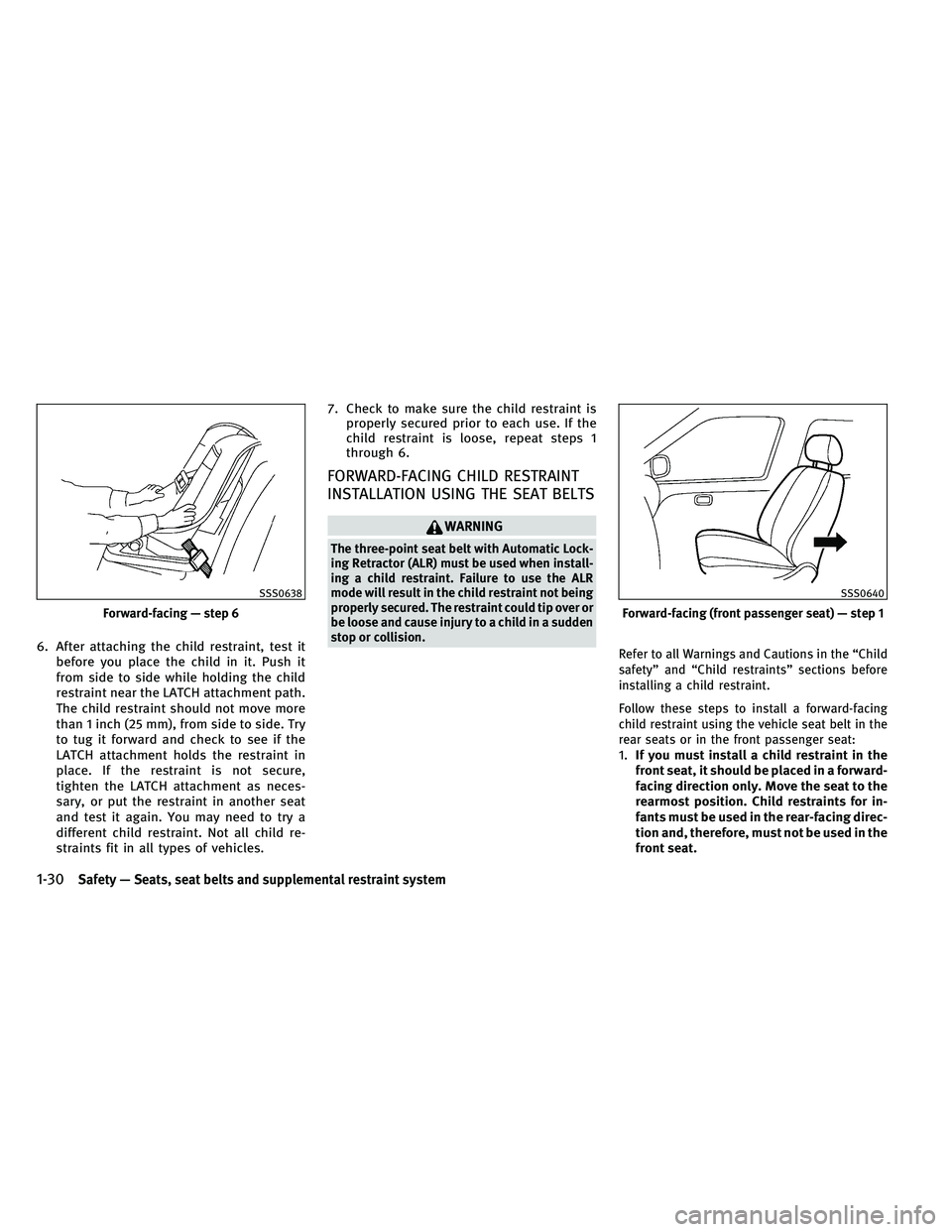
6. After attaching the child restraint, test itbefore you place the child in it. Push it
from side to side while holding the child
restraint near the LATCH attachment path.
The child restraint should not move more
than 1 inch (25 mm), from side to side. Try
to tug it forward and check to see if the
LATCH attachment holds the restraint in
place. If the restraint is not secure,
tighten the LATCH attachment as neces-
sary, or put the restraint in another seat
and test it again. You may need to try a
different child restraint. Not all child re-
straints fit in all types of vehicles. 7. Check to make sure the child restraint is
properly secured prior to each use. If the
child restraint is loose, repeat steps 1
through 6.
FORWARD-FACING CHILD RESTRAINT
INSTALLATION USING THE SEAT BELTS
WARNING
The three-point seat belt with Automatic Lock-
ing Retractor (ALR) must be used when install-
ing a child restraint. Failure to use the ALR
mode will result in the child restraint not being
properly secured. The restraint could tip over or
be loose and cause injury to a child in a sudden
stop or collision.
Refer to all Warnings and Cautions in the “Child
safety” and “Child restraints” sections before
installing a child restraint.
Follow these steps to install a forward-facing
child restraint using the vehicle seat belt in the
rear seats or in the front passenger seat:
1.If you must install a child restraint in the
front seat, it should be placed in a forward-
facing direction only. Move the seat to the
rearmost position. Child restraints for in-
fants must be used in the rear-facing direc-
tion and, therefore, must not be used in the
front seat.
Forward-facing — step 6
SSS0638
Forward-facing (front passenger seat) — step 1
SSS0640
1-30Safety — Seats, seat belts and supplemental restraint system
Page 50 of 480
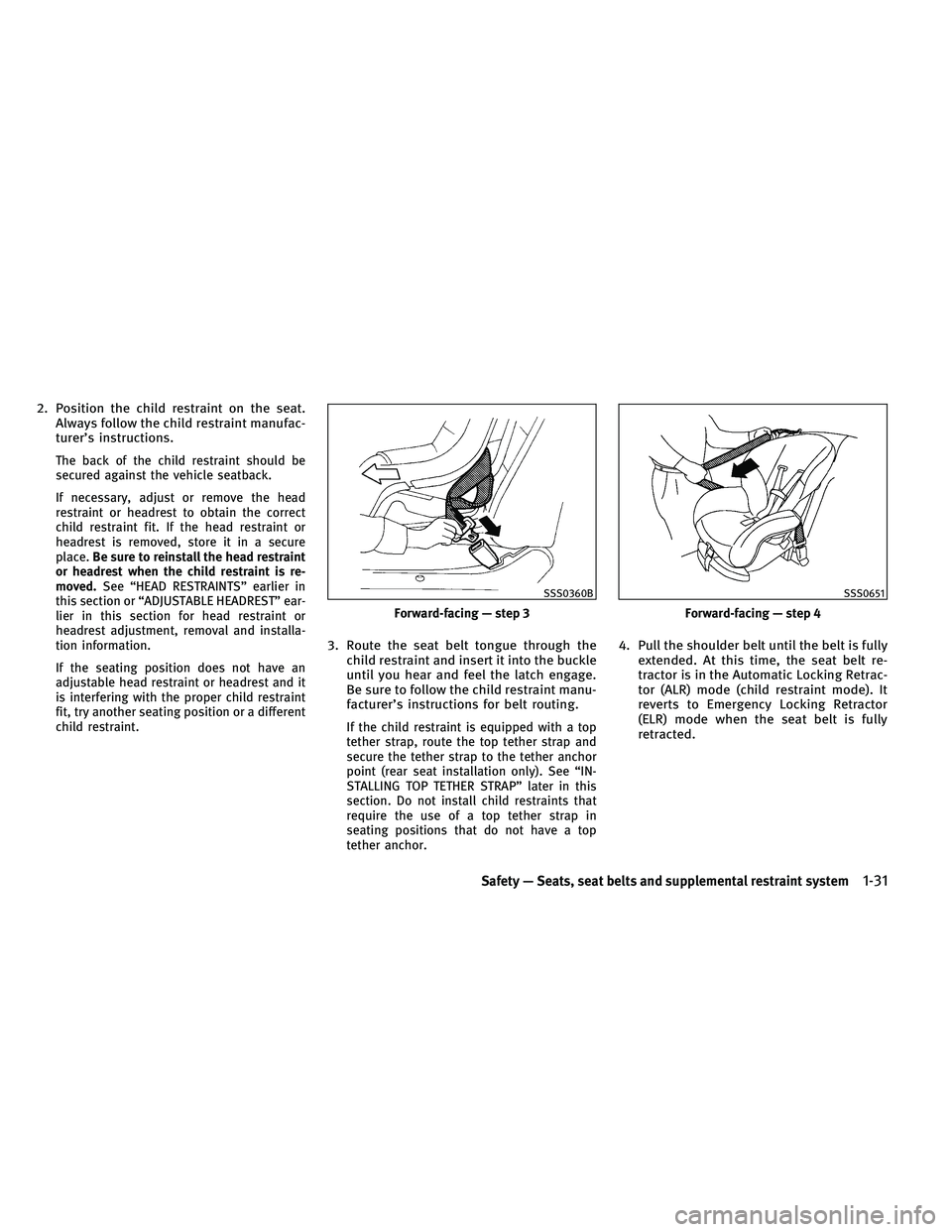
2. Position the child restraint on the seat.Always follow the child restraint manufac-
turer’s instructions.
The back of the child restraint should be
secured against the vehicle seatback.
If necessary, adjust or remove the head
restraint or headrest to obtain the correct
child restraint fit. If the head restraint or
headrest is removed, store it in a secure
place. Be sure to reinstall the head restraint
or headrest when the child restraint is re-
moved. See “HEAD RESTRAINTS” earlier in
this section or “ADJUSTABLE HEADREST” ear-
lier in this section for head restraint or
headrest adjustment, removal and installa-
tion information.
If the seating position does not have an
adjustable head restraint or headrest and it
is interfering with the proper child restraint
fit, try another seating position or a different
child restraint.
3. Route the seat belt tongue through the child restraint and insert it into the buckle
until you hear and feel the latch engage.
Be sure to follow the child restraint manu-
facturer’s instructions for belt routing.
If the child restraint is equipped with a top
tether strap, route the top tether strap and
secure the tether strap to the tether anchor
point (rear seat installation only). See “IN-
STALLING TOP TETHER STRAP” later in this
section. Do not install child restraints that
require the use of a top tether strap in
seating positions that do not have a top
tether anchor.
4. Pull the shoulder belt until the belt is fully extended. At this time, the seat belt re-
tractor is in the Automatic Locking Retrac-
tor (ALR) mode (child restraint mode). It
reverts to Emergency Locking Retractor
(ELR) mode when the seat belt is fully
retracted.
Forward-facing — step 3
SSS0360B
Forward-facing — step 4
SSS0651
Safety — Seats, seat belts and supplemental restraint system1-31